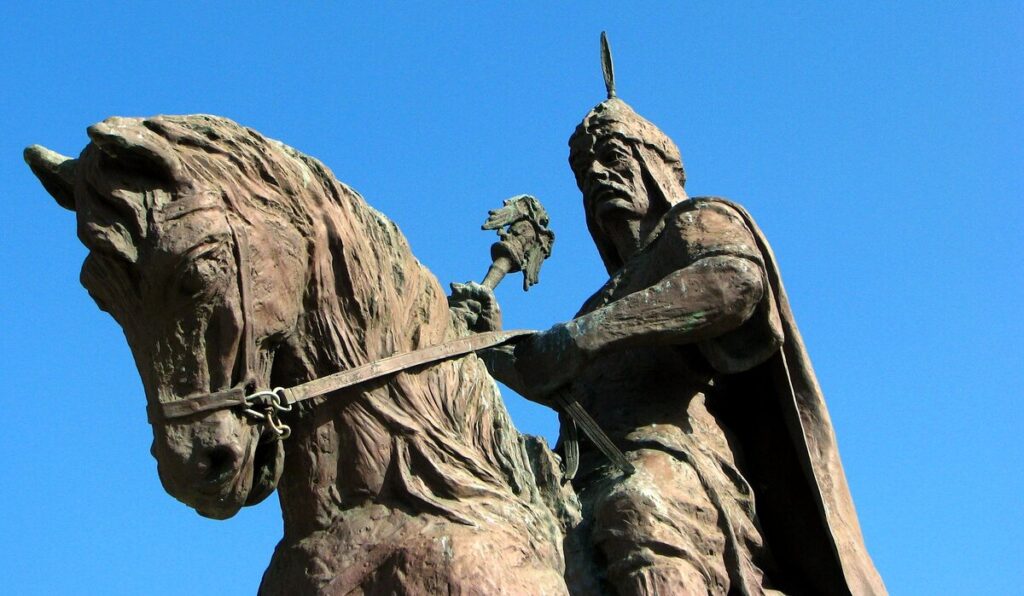The Seljuk Turks, back in the period of their power, at the beginning of the XIII century, tried to lay their hands on the Crimea.
In the 1220s, the Konya Sultan Kei-Kubad I sent an expeditionary force to the Crimean Peninsula. The Turks captured Sudak there.
But soon, the Mongols who came drove the Seljuk Turks back into the sea and captured the entire Crimea.

Ala al-Din Kei-Kubad I was the Seljuk ruler of the Konya Sultanate (1219/1220—1236/1237), under which the state reached its heyday.
And soon the Mongols reached the Koni Sultanate (Rum) itself.
On June 26, 1243, the Mongols defeated the Konya Sultan Kay Khosrow II in the Battle of Kes-dagh. The sultan became a vassal of Batu Khan, and annually had to send 12 million silver coins, 500 pieces of silk, 500 camels and 5,000 sheep to Karakorum.
After the death of Kay Khosrow in 1245, his three sons fought for the throne.
One of them, the eldest son of Kay Kavus, was from a Greek concubine and favored the Byzantines. The second son, Kilic Arslan, enjoyed the support of the Mongols. The third son of Kay Kubad from the Georgian princess Tamar died in these feuds.
Kay Kavus tried to rebel against Ilkhan Hulagu, but was defeated.

Hulagu (1217 — February 8, 1265, Meraghe, Iranian Azerbaijan) was a Mongol ruler and military commander. Grandson of Genghis Khan, son of Tolui and Sorkhakhtani, brother of kaans Mongke and Kublai. The founder of the Hulaguid dynasty, who ruled in the Iranian Ilkhanate he created in the Near East — Wikipedia
Only the intercession of Hulagu’s wife, Dokuz Khatun, who was herself a Keraite Christian, saved Kay Kavus’s life. Kay Kavus was allowed to retire in 1261 to the Greeks in Constantinople, where he lived at the court of the Byzantine Emperor Michael VIII Palaiologos.
This is how Kay Kavus would have lived his whole life in Constantinople, but then hostilities began between the ruler of the Great Ulus Berke and Hulagu for the right to possess Transcaucasia.
Berke decided to use Kay Kavus to be his puppet in case it would be necessary to put someone at the head of the Seljuks instead of the pro-Gulaguid Kilic Arslan.

Michael VIII Palaiologos (1224/1225 — December 11, 1282) was the Byzantine emperor from 1261 (as the Nicene Emperor — from 1259), the founder of the Palaiologos dynasty.
In 1265, Berke demanded Kay Kavus from the Byzantines and gave him possession of land in the eastern part of the Crimea.
At that time, the Kipchaks were driven out of the steppe zone of Crimea. The settled population of the Khazars, Armenians, Greeks and Goths governed themselves, paying only taxes to the Mongols. As such, the Mongols did not have a governor in Crimea.
Therefore, Kay Kavus was granted the rights of not just a governor, but the ruler of the eastern Crimea. He even started minting coins with the name of the Baghdad Caliph An-Nasir.
Together with the Koni Sultan, many Seljuk Turks migrated to the Crimea, who began to actively settle in the possessions of Kay Kavus.
Kay Kavus, without expecting it, became the ruler of the eastern Crimea, and in fact the first governor of the Mongols on the peninsula.
Kay Kavus was never useful to Berke, and lived until 1280, outliving his patron by 14 years.
